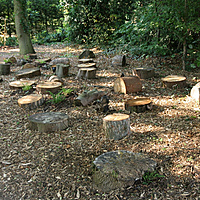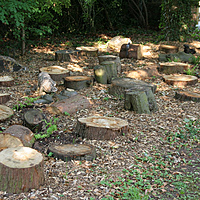October 2008
If I only had one space in the garden for a fruit tree, it would be a greengage. We have a rather elderly specimen here that crops sparsely at the best of times, but the fruit is absolutely delicious. A couple of years ago we got a relatively heavy harvest. For an easy pudding I halved and stoned the gages and put them in a buttered baking dish. Sprinkled with brown sugar, baked for about half an hour and served with vanilla ice cream - they didn't last long!
Second choice would be a plum. I tried to find out what the difference is between a plum and a 'gage'. If you will excuse the pun, it wasn't a very fruitful search. All I can pass on to you is that the first gages in this country were imported from France in 1725 by Sir William Gage. As a result he gave his name to sweet yellow plums that became a Victorian delicacy.
We do have a Marjories Seedling tree which has large, purple and juicy plums; at their best about now. This variety is especially good as it is both self fertile and late flowering, avoiding frost damage to the flowers early in the season. Plums and 'gages like an open, sunny spot and little or no pruning. If you do need to prune, set to in Spring or Summer when the sap is rising. When choosing a plum tree, check to see if it needs a pollinator nearby and what rootstock it is grafted on to. A dwarfing rootstock is obviously best for a small garden.
You don't need me to tell you what another rubbish summer we have had. To keep my spirits up and look ahead to what must be better weather for gardeners next year, I'm going to sow some sweet peas now. The last time I tried an Autumn sowing, our resident greenhouse mice ate the tasty new shoots, so I have some wire ready to protect them. The Grandiflora varieties have the best scent, which I love, so I will sow them soon in our cold greenhouse; a few seeds in a tall pot to give them a good root run. They shouldn't want any heat unless it gets down to Arctic temperatures and, after being well watered at the start, they will only need a little. In the spring I will harden them off outside, pinching out the tips when they reach about 10 cm. Eventually they will be planted out in a well manured and sunny spot, to grow up some netting. If you prefer larger flowers rather than strong perfume, the Spencer varieties are best.
I usually plant sweet peas in the vegetable patch to brighten it up a bit and to encourage beneficial insects, but I have seen them growing up fancy wigwams in quite posh gardens. It's a quick way of getting a bit of height into a border, it can also work well with perennial climbers such as clematis.
Now Autumn is upon us and the leaves are starting to fall, it's time to plan for the future and start off some leaf mould. All you need to do is fill some black plastic bags full of damp leaves, tie the top and make a few holes in the bag. Stick them behind the shed where they won't annoy you and leave them for at least a year, preferably two. The leaves will turn into beautiful dark, crumbly compost and it's one of the best soil conditioners around.
My next project for a dark area of the garden is a stumpery – I'll let you know if it works!

